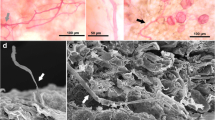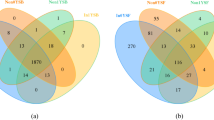Abstract
Soybean (Glycine max) agriculture is characterized by a high proportion of mono-cropping which results in reduced crop production in the Northeast China. Among all biotic and abiotic factors, changes in soil microbial communities induced by root activities, especially root exudates, might play an important role in these effects. The aim of the present study was to investigate response of microbial biomass and two major beneficial microbial functional groups, ammonia-oxidizing bacteria (AOB), and arbuscular mycorrhizal fungi (AMF), to root exudates in an experimental field under continuous soybean monoculture for 13 years. The results showed that microbial biomass carbon changed significantly with years of mono-cropping and correlated with concentrations of genistein (r = 0.4399, P < 0.001) and daidzein (r = 0.4082, P < 0.05) in the rhizosphere. However, root exudates had little effect on the nitrifier community, but reduced nitrification in the rhizosphere. In contrast, total AMF hyphal length was significantly stimulated by genistein (r = 0.5252, P < 0.01). There was a trend that AMF spore density increased in the rhizosphere with increasing years of mono-cropping, while AMF infection was constant over time, which might be attributed to competition between AMF and soil-borne fungal pathogens, as the results of stimulatory effect of flavonoids on fungal community, especially fungal pathogens. Our results suggested that the yield reduction in the beginning of continuous soybean monoculture could be partially attributed to nitrogen availability and yield stabilization after few years to stimulatory effects on AMF. These results imply that some of plant root exudates play a crucial role in changing the soil microbial community, and that underground ecosystem functioning is also affected by interactions among microbial functional groups.







Similar content being viewed by others
References
Aroca R, Porcel R, Ruiz-Lozano JM (2007) How does arbuscular mycorrhizal symbiosis regulate root hydraulic properties and plasma membrane aquaporins in Phaseolus vulgaris under drought, cold or salinity stresses? New Phytol 173:808–816
Avrahami S, Bohannan BJM (2007) Response of Nitrosospira sp. strain AF-like ammonia oxidizers to changes in temperature, soil moisture content, and fertilizer concentration. Appl Environ Microbiol 73:1166–1173
Bever JD (2002) Host-specificity of AM fungal population growth rates can generate feedback on growth. Plant Soil 244:281–290
Bever JD (2003) Soil community feedback and the coexistence of competitors: conceptual frameworks and empirical tests. New Phytol 157:465–473
Bouwmeester HJ, Roux C, Lopez-Raez JA, Becard G (2007) Rhizosphere communication of plants, parasitic plants and AM fungi. Trends Plant Sci 12:224–230
Bünemann EK, Steinebrunner F, Smithson PC, Frossard E, Oberson A (2004) Phosphorus dynamics in a highly weathered soil as revealed by isotopic labeling techniques. Soil Sci Soc Am J 68:1645–1655
Cesco S, Neumann G, Tomasi N, Pinton R, Weisskopf L (2010) Release of plant-borne flavonoids into the rhizosphere and their role in plant nutrition. Plant Soil 329:1–25
Chen HY, Li XM, Wang JG (2005) Changes of microflora in the rhizoplane and rhizosphere of different disease soybean cultivar. I. Changes of microflora in the rhizoplane and rhizosphere of soybean under normal rotation condition (In Chinese). Plant Nutr Fert Sci 11:804–809
Chen HY, Li XM, Wang JG (2006) Changes of microflora in the rhizoplane and rhizosphere of different disease soybean cultivar. II. Changes of microflora in the rhizoplane and rhizosphere of soybean under continuous cropping condition (In Chinese). Plant Nutr Fert Sci 12:104–108
Colpas FT, Ono EO, Rodrigues JD, de Souza Passos JR (2003) Effects of some phenolic compounds on soybean seed germination and on seed-borne fungi. Braz Arch Biol Technol 46:155–161
Daniels BA, Skipper HD (1982) Methods for the recovery and quantitative estimation of propagules from soil. In: Schenck NC (ed) Methods and principles of mycorrhizal research. American Phytopathological Society, St. Paul, pp 29–35
de la Peña E, Echeverría SR, van der Putten WH, Freitas H, Moens M (2006) Mechanism of control of root-feeding nematodes by mycorrhizal fungi in the dune grass Ammophila arenaria. New Phytol 169:829–840
Franche C, Lindstrom K, Elmerich C (2009) Nitrogen-fixing bacteria associated with leguminous and non-leguminous plants. Plant Soil 321:35–59
Ge Y, Zhang JB, Zhang LM, Yang M, He JZ (2008) Long-term fertilization regimes affect bacterial community structure and diversity of an agricultural soil in Northern China. J Soil Sediment 8:43–50
Gil SV, Meriles JM, Haro R, Casini C, March GJ (2008) Crop rotation and tillage systems as a proactive strategy in the control of peanut fungal soilborne diseases. Biocontrol 53:685–698
Guo ZY, Kong CH, Wang JG, Wang YF (2011) Rhizosphere isoflavones (daidzein and genistein) levels and their relation to the microbial community structure of mono-cropped soybean soil in field and controlled conditions. Soil Biol Biochem 43:2242–2257
Han LM, Shen QR, Ju HY, Yan S, Yan F (2002) Allelopathy of the aqueous extracts of above ground parts of soybean and the identification of the allelochemicals (In Chinese). Acta Ecol Sin 22:1425–1432
Hu JC, Xue DL, Wang SJ (1998) Obstacles of soybean continuous cropping II: mechanism of soybean yield decline and control strategies for toxin of Penicillium purouregenum in soils (In Chinese). Chin J Appl Ecol 9:429–434
Jansa J, Mozafar A, Anken T, Voulgari OK, Mamolos AP, Alifragis DA, Veresoglou DS (2002) Diversity and structure of AMF communities as affected by tillage in a temperate soil. Mycorrhiza 12:225–234
Jia ZJ, Conrad R (2009) Bacteria rather than archaea dominate microbial ammonia oxidation in an agricultural soil. Environ Microbiol 11:1658–1671
Kulmatiski A, Beard KH, Stevens JR, Cobbold SM (2008) Plant-soil feedbacks: a meta-analytical review. Ecol Lett 11:980–992
Lambers H, Mougel C, Jaillard B, Hinsinger P (2009) Plant-microbe-soil interactions in the rhizosphere: an evolutionary perspective. Plant Soil 321:83–115
Leininger S, Urich T, Schloter M, Schwark L, Qi J, Nicol GW, Prosser JI, Schuster SC, Schleper C (2005) Archaea predominate among ammonia-oxidizing prokaryotes in soils. Nature 442:806–809
Li CG, Li XM, Kong WD, Wu Y, Wang JG (2010) Effect of monoculture soybean on soil microbial community in the Northeast China. Plant Soil 330:423–433
Lin QM, Wu YG, Liu HL (1999) Modification of fumigation extraction methods for measuring soil microbial biomass carbon (In Chinese). Chin J Ecol 18:63–66
Liu XB, Herbert SJ (2002) Fifteen years of research examining cultivation of continuous soybean in Northeast China: a review. Field Crops Res 79:1–7
Majumdar D, Dutta A, Kumar S, Pathak H, Jain MC (2001) Mitigation of N2O emission from an alluvial soil by application of karanjin. Biol Fert Soil 33:438–442
Masamune T, Anetai M, Takasugi M, Katsui N (1982) Isolation of a natural hatching stimulus, glycinoeclepin A, for the soybean cyst nematode. Nature 297:495–496
Michelson A, Rosendahl S (1990) The effect of VA mycorrhizal fungi, phosphorus and drought stress on the growth of Acacia nilotica and Leucaena leucocephala seedlings. Plant Soil 124:7–13
Miller MH, McGonigle TP, Addy HD (1995) Functional ecology of vesicular-arbuscular mycorrhizas as influenced by phosphate fertilization and tillage in an agricultural ecosystem. Crit Rev Biotechnol 15:241–255
Oehl F, Sieverding E, Ineichen K, Mader P, Boller T, Wiemken A (2003) Impact of land use intensity on the species diversity of arbuscular mycorrhizal fungi in agroecosystems of Central Europe. Appl Environ Microbiol 69:2816–2824
Oehl F, Sieverding E, Ineichen K, Mader P, Boller T, Wiemken A, Dubois D (2004) Impact of long-term conventional and organic farming on the diversity of arbuscular mycorrhizal fungi. Oecologia 138:574–583
Oehl F, Sieverding E, Ineichen K, Ris EA, Boller T, Wiemken A (2005) Community structure of arbuscular mycorrhizal fungi at different soil depths in extensively and intensively managed agroecosystems. New Phytol 165:273–283
Pankhurst CE, Ophel-Keller K, Doube BM, Gupta VVSR (1996) Biodiversity of soil microbial communities in agricultural systems. Biodiv Conserv 5:197–209
Qu XH, Wang JG (2008) Effect of amendments with different phenolic acids on soil microbial biomass, activity, and community diversity. Appl Soil Ecol 39:172–179
Rotthauwe JH, Witzel KP, Liesack W (1997) The ammonia monooxygenase structural gene amoA as a functional marker: molecular fine-scale analysis of natural ammonia-oxidizing populations. Appl Environ Microbiol 63:4704–4712
Ruan WB, Wang JG, Zhang FS (2003) The effect of continuous cropping factors on soybean seedling growth and nitrogen fixation (In Chinese). Acta Ecol Sin 23:22–29
Sieverding E (1990) Ecology of VAM fungi in tropical agrosystems. Agri Ecosyst Environ 29:369–390
Skiba MW, George TS, Baggs EM, Daniell TJ (2011) Plant influence on nitrification. Biochem Soc Trans 39:851–856
Smithson PC, Giller KE (2002) Appropriate farm management practices for alleviating N and P deficiencies in low-nutrient soils of the tropics. Plant Soil 245:169–180
Smits NAC, Bobbink R, Laanbroek HJ, Paalman AJ, Hefting MM (2011) Repression of potential nitrification activities by matgrass sward species. Plant Soil 337:435–445
Song YN, Zhang FS, Marschner P, Fan FL, Gao HM, Bao XG, Sun JH, Li L (2007) Effect of intercropping on crop yield and chemical and microbiological properties in rhizosphere of wheat (Triticum aestivum L.), maize (Zea mays L.), and faba bean (Vicia faba L.). Biol Fert Soils 43:565–574
Steinkellner S, Lendzemo V, Langer I, Schweiger P, Khaosaad T, Toussaint JP, Vierheilig H (2007) Molecules, flavonoids and strigolactones in root exudates as signals in symbiotic and pathogenic plant-fungus interactions. Molecules 12:1290–1306
Suarez-Ojeda ME, Guisasola A, Carrera J (2010) Inhibitory impact of quinone-like compounds over partial nitrification. Chemosphere 80:474–480
Subbarao GV, Nakahara K, Hurtado MP, Ono H, Moreta DE, Salcedo AF, Yoshihashi AT, Ishikawa T, Ishitani M, Ohnishi-Kameyama M, Yoshida M, Rondon M, Rao IM, Lascano CE, Berry WL, Ito O (2009) Evidence for biological nitrification inhibition in Brachiaria pastures. Proc Natl Acad Sci USA 106:17302–17307
Tanaka JP, Nardi P, Wissuwa M (2011) Nitrification inhibition activity, a novel trait in root exudates of rice. AoB plants plq014. doi: 10.1093/aobpla/plq014
Taylor AE, Zeglin LH, Dooley S, Myrold DD, Bottomley PJ (2010) Evidence for different contributions of archaea and bacteria to the ammonia-oxidizing potential of diverse Oregon Soils. Appl Environ Microbiol 76:7691–7698
Trouvelot A, Kough JL, Gianinazzi-Pearson V (1986) Mesure du taux de mycorrhization VA d’un systeme radiculaire. Recherche des methodes d’estimation ayant une signification functionnelle. In: Gianinazzi-Pearson V, Gianinazzi S (eds) Physiological and genetical aspects of mycorrhizae. INRA, Paris, pp 217–221
Tyler BM, Wu MH, Wang JM, Cheung W, Morris PF (1996) Chemotactic preferences and strain variation in the response of Phytophthora sojae zoospores to host isoflavones. Appl Environ Microbiol 62:2811–2817
Utkhede RS (2006) Soil sickness, replant problem or replant disease and its integrated control. Allelopathy J 18:23–38
van der Heijden MGA, Klironomos JN, Ursic M (1998) Mycorrhizal fungal diversity determines plant biodiversity, ecosystem variability and productivity. Nature 396:69–72
Vigo C, Norman JR, Hooker JE (2000) Biocontrol of the pathogen Phytophthora parasitica by arbuscular mycorrhizal fungi is a consequence of effects on infection loci. Plant Pathol 49:509–514
Westover KM, Kennedy AC, Kelley SE (1997) Patterns of rhizosphere microbial community structure associated with co-occurring plant species. J Ecol 85:863–873
Xu YL, Chen YL, Si ZS, Li ZL, Li CJ, Wen GY (2004) The effects of the root diffusate of different crops from different rotation systems on the egg hatch of soybean cyst nematode Heterodera glycines (In Chinese). Acta Phytopathol Sin 34:481–486
Zeglin LH, Taylor AE, Myrold DD, Bottomley PJ (2011) Bacterial and archaeal amoA gene distribution covaries with soil nitrification properties across a range of land uses. Environ Microbiol Rep 3:717–726
Zhang SX, Gao ZQ, Liu HL (2000) Continuous cropping obstacle and rhizospheric microecology III. Soil phenolic acids and their biological effect (In Chinese). Chin J Appl Ecol 11:741–744
Zhang JY, Wang JG, Xu YL, Li HG (2007) Effect of nitrogen on the species and content of organic acids in root exudates of different soybean cultivars (In Chinese). Plant Nutr Fert Sci 13:398–403
Acknowledgments
This work was supported by the National Natural Science Foundation of China (NSFC) (40871121) and the innovative group grant of Natural Science Foundation of China (31121062).
Author information
Authors and Affiliations
Corresponding author
Rights and permissions
About this article
Cite this article
Wang, J., Li, X., Zhang, J. et al. Effect of root exudates on beneficial microorganisms—evidence from a continuous soybean monoculture. Plant Ecol 213, 1883–1892 (2012). https://doi.org/10.1007/s11258-012-0088-3
Received:
Accepted:
Published:
Issue Date:
DOI: https://doi.org/10.1007/s11258-012-0088-3




